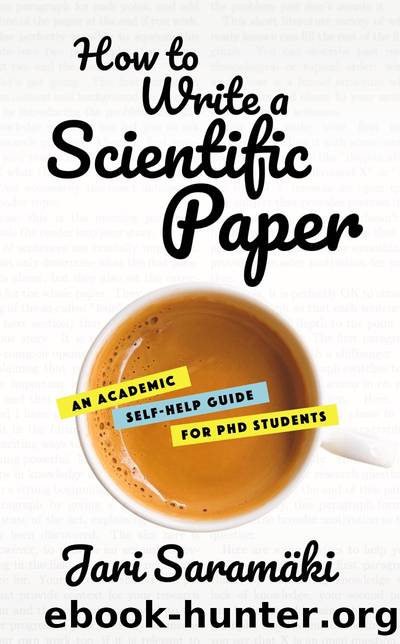How to Write a Scientific Paper by Jari Saramäki

Author:Jari Saramäki
Language: eng
Format: epub
Publisher: Jari Saramäki
11
How To Write The Results, Part II: Text
âThe scientist only imposes two things, namely truth and sincerity, imposes them upon himself and upon other scientists.â â Erwin Schrödinger
The arc of the results section follows the order of the figures, from the setup to the confrontation and from the resolution to the epilogue. The results of the first phase (setup) introduce the reader to your data. They make your final conclusions credible by showing what is in your data and letting the reader gauge whether it looks OK. The results of the second phase (confrontation) point out that there is something surprising that needs to be sorted out. The results of the third phase present the resolution of the problem, and the results of the epilogue phase show what follows from the main finding and why that matters. They would not necessarily work as stand-alone results.
Make sure that the reader can easily follow the arc. She should always know where she is and where she is heading next. One way of making sure the reader is on the map is to further divide your results into subcategories, discussed in their own subsections that come with informative headings. You can develop subsection headings by condensing each result into a single short sentence and then using this sentence as your heading. This way, each result gets its own subsection where it can be explained in detail. Note here that âa resultâ does not necessarily mean a single plot or figure but rather a conclusion that may be based on several pieces of evidence.
With your results section organised in this way, the reader can get a quick overview of the whole section by scanning the subsection headings and the figure captions. Again, remember that most readers just skim.
The above technique is an example of so-called signposting, where the whole paper is made more accessible by covering it with signposts that tell the reader where she is. Clear section headings help, as do clear figure captions whose first sentence should explain what the figure is about. Clearly formulated key phrases are also very useful.
In your Results section, the most important signposts are the subsection headings, the first sentences of figure captions, and something we havenât discussed yet: the first sentence of each results subsection. These sentences should motivate and provide background for the subsection: why was this experiment conducted? Why was the analysis done that led to this result, and why are we discussing this result? A useful construct to launch the first sentence of a results subsection is âTo understand X, we measured Yâ¦ââor something similar. Even though the motivation has already been mentioned in the Introduction and possibly in the Methods as well, it is still good practice to begin with a sentence that reminds the reader of why she is reading this part (unless the paper is a very short letter and the introduction appears just a few paragraphs earlier).
So, what else is there in a results subsection? Well, results, of course. But there are several layers here.
Download
This site does not store any files on its server. We only index and link to content provided by other sites. Please contact the content providers to delete copyright contents if any and email us, we'll remove relevant links or contents immediately.
Asking the Right Questions: A Guide to Critical Thinking by M. Neil Browne & Stuart M. Keeley(5649)
Autoboyography by Christina Lauren(5184)
Eat That Frog! by Brian Tracy(4436)
Dialogue by Robert McKee(4323)
Sticky Fingers by Joe Hagan(4103)
Journeys Out of the Body by Robert Monroe(3572)
Annapurna by Maurice Herzog(3424)
Full Circle by Michael Palin(3389)
Schaum's Quick Guide to Writing Great Short Stories by Margaret Lucke(3321)
Elements of Style 2017 by Richard De A'Morelli(3307)
The Art of Dramatic Writing: Its Basis in the Creative Interpretation of Human Motives by Egri Lajos(3017)
Atlas Obscura by Joshua Foer(2900)
The Diviners by Libba Bray(2887)
Why I Write by George Orwell(2877)
In Patagonia by Bruce Chatwin(2876)
The Fight by Norman Mailer(2848)
The Mental Game of Writing: How to Overcome Obstacles, Stay Creative and Productive, and Free Your Mind for Success by James Scott Bell(2845)
Venice by Jan Morris(2526)
The Elements of Style by William Strunk and E. B. White(2442)
